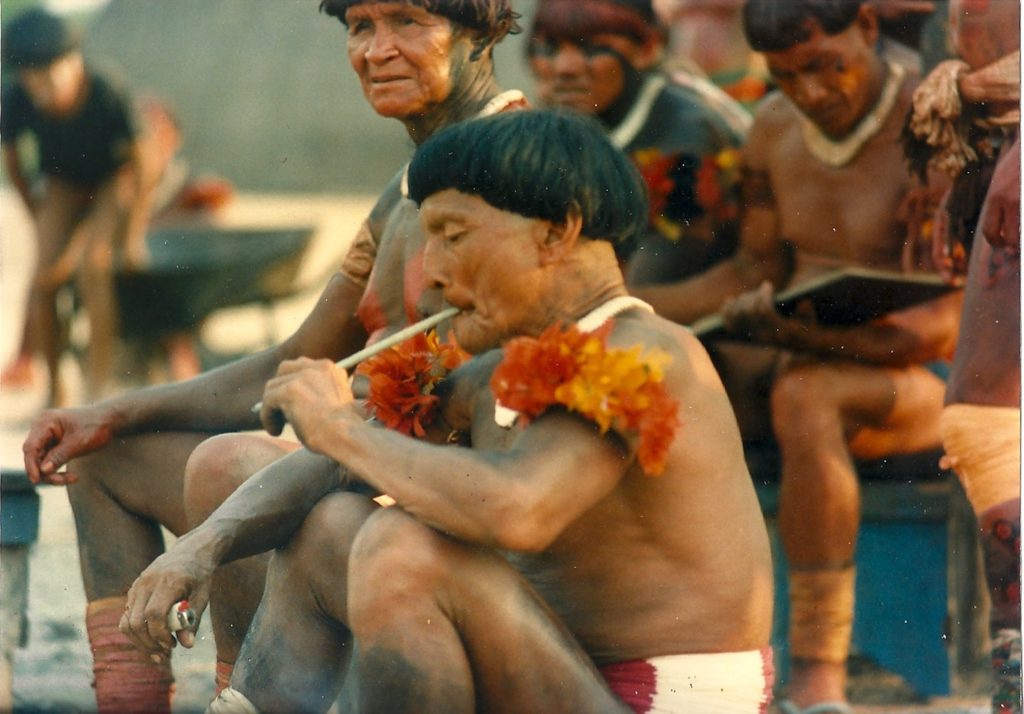Thursday March 28, 7:30pm
Paula Gaitán
“Uaká” (1988)
Paula Gaitán in person
Organized with Steve Holmgren

From “Uaká” (1988) by Paula Gaitán – Image courtesy of the artist
We are pleased to invite you to an informal screening with the artist of the 1988 film “Uaká” (Sky), the first feature film by Brazilian-Colombian filmmaker Paula Gaitán. The work, which received a special prize at the 1988 Festival International du Film d’Amiens, was shot in the Amazon Basin of Brazil and uses as its subject matter the creation myth of the Kamaiurá tribe of the upper Xingu. Short sequences from Méliès’ Voyage dans la lune (Voyage to the Moon) are interspersed.
“The only explanations in the film are provided by the Indians whose voices are occasionally subtitled and carried over the image track. They describe the importance of quarup, a festival honoring Mavutsinim, a deity who enables the people of Xingu to be eternal. Early in the film, it is explained that the clouds draw figures and messages that help the people to dream of Mavutsinim.” — Catherine Russell, 1999
“Uaká/Sky leaves us with a sense of textures, colors, and rhythms, actions, gestures, and rituals that elude any one strategy for comprehension without ever suggesting that the events are incomprehensible or merely raw material for poetic expression”. — Bill Nichols, 1991
The approximately 90-minute work will be screened in its original 16mm film format. The artist will be in attendance and the event, organized with Steve Holmgren, is open to the public.
Paula Gaitán will be joined by Joana Brandao and André Lopes in a conversation following the screening.
Free admission
Program:
“Uaká” (Sky)
Directed and written by Paula Gaitán, 16mm film, color, sound, 1988, 90 minutes
Cámera: Jonhy Howard
Editing: Paula Gaitán and Aida Marquez
Sound Design: Carlos Alberto Camuirano and Paula Gaitán
Cast: Takuman, Ianaculá, Sapaim
In the midst of the Brazilian jungle, near the mountains separating the Amazon River from Bolivia lies the Xingu, a region unknown to outsiders as recently as twenty years ago. The Xingu creation myth is the subject of this first feature by Paula Gaitan, who shows how well she has learned the lessons of cinema nôvo. Neither documentary nor fiction-and still less an ethnographic film-it’s best described as an “image poem” about the quarup ritual. Sky depicts a culture thousands of years old still living according to its own legends: the hero Mavutsinim was the first to learn how to revive the dead, by chanting songs before wooden trunks (quarups) decorated and painted with images of the dead. Resurrection could only take place if this magical practice remained secret. But men betrayed their promise and tried to discover Mavutsinim’s secret. From that day forth the dead have been unable to return to life. Today those whose dead are honored must remain in mourning for an entire year, not participating in any tribal activity. Then they are led to the center of the village for a symbolic purifying bath where their bodies are made up to mark the end of mourning. The next day the quarup trunks are thrown into the river which transports the dead to a new existence in another world. – Festival International du Film d’Amiens, 1988
_
Paula Gaitán was born in Paris in 1954. She is an artist, a photographer, a poet and a filmmaker. After graduating in Visual Arts from Los Andes University in Bogotá (Colombia), Gaitán moved to Brazil in 1977 and the following year started working in film as artistic director for A idade da terra (The Age of the Earth) by Glauber Rocha. She has directed dozens of documentaries, videos and installations for several individual and collective exhibitions. Among her films are Diário de Sintra (Days in Sintra, 2007), on the experience of living in the small Portuguese town of Sintra with her partner Glauber Rocha and their children, and Lygiapape (1991) an interpretation of the work by Brazilian artist Lygia Pape. Her films have been shown in numerous festivals such as Bafici, Viennale, Tribeca, Havana, Cartagena, Sao Paulo Mostra International Film Festival, Pesaro, Guadalajara, Amiens, FIDMarseille, San Francisco, among others. Gaitán is lives and works in Sao Paulo, Brazil.
Joana Brandao is Professor of Arts and Audiovisual at the Federal University of South of Bahia, Brazil, and is currently Visiting Scholar in the Department of Anthropology, New York University. She holds a Bachelor and a Master degree in Journalism and is a Ph.D candidate in Gender studies at the Federal University of Bahia. She has been working with indigenous peoples since 2010, giving training in media and communication especially among women, and is developing her Ph.D research on cinema of Brazilian indigenous women. As filmmaker, she has produced two short-documentaries and is pre-producing her first feature-film about indigenous women leadership in the Northeast Brazil.
André Lopes is a visiting scholar at NYU Anthropology under the guidance of Professor Faye Ginsburg and a PhD student at the University of São Paulo. He has been conducting video workshops for indigenous peoples since 2011 and has experience directing collaborative documentaries.

Paula Gaitán, 1988 – Image courtesy of the artist
